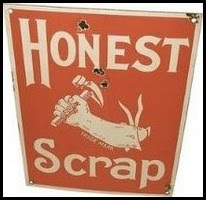Every kitchen needs to have certain tools for cooking and baking. You don't need to have every new and fancy gadget that comes out on the market (although some of those gadgets are cool and can be useful), but you should have some basics.
Today's Monday Must Have is one of those basics--the Rolling Pin.
Rolling pins come in several styles, shapes and sizes, materials and even different colors. I own four or five, but the one I typically use for most of my rolling needs is the Straight Rolling Pin, sometimes also referred to as the French-style rolling pin (but not to be confused with the French Tapered Rolling Pin).
I first used a Straight Rolling Pin in culinary school. In fact, the one pictured above is the very same one that came as part of my culinary tool kit. At first, I wasn't sure if I liked it. Growing up, I'd always used the type of rolling pin with the handles and that was what I was used to. The first time I used the Straight Rolling Pin, well to be honest, it was a frustrating experience. It felt awkward and strange to use the palm of my hands on the pin, instead of keeping them on the handles.
It was so different to me, that I was resistant to changing over to it. In fact, in one of my first classes, I opted to use the regular rolling pins when learning to roll out pastry dough--until the Chef came over and explained why he loved using the Straight Rolling Pin for rolling out many types of dough. He encouraged me to give it another try and showed me the advantages to using this type of rolling pin and once I got the hang of it and had a bit more practice, I understood how this tool was a very valuable part of my collection.
The Pros of the Straight Rolling Pin:
Balance ~ The straight rolling pin is uniformly balanced and can roll out larger amounts of dough because it is longer than a rolling pin with handles. This balance helps to roll out the dough evenly and with some practice, it is easy to use.
Control ~ Because you are using the weight of the pin to help roll the dough out and also depending on your touch, you can add more pressure and feel the dough as it rolls out or add less pressure if you only need a little more.
When starting to roll out your dough, it's best to add more pressure and this can be achieved by pressing down with the palms of your hands to help spread and roll the dough out to the desired thickness.
For less pressure, roll the pin over the dough using the tips of your fingers to control the rolling pin. I keep a lighter touch towards the end of the rolling process and this allows me to feel the thickness of the dough and to make sure it is evenly rolled out.
Relaxed ~ I actually find myself more relaxed while rolling out dough, because I'm not gripping the handles and forgetting that I'm not handling the dough gently enough. Also, this type of rolling pin allows you to be closer to the dough and you are able to feel the dough's thickness while rolling it out and make the necessary adjustments through the pressure from your hands on the rolling pin.
Size ~ The Straight Pin is 18-inches long, vs. the handled rolling pin which is about 10-inches long. This is helpful in not adding edging dents which can occur with the other type of rolling pin at times.
How-to-Care for your Straight Rolling Pin:
Before using a brand new rolling pin, it needs to be oiled, to help protect the wood from drying, spliting or cracking. Mineral Oil is the best type of oil to use for protecting wooden kitchen tools and should be used rather than vegetable oil. Vegetable oil can turn rancid and that in turn, produces an unpleasant oder and flavor; not what you want on your beautiful pastry dough. Follow the recommended directions on the Mineral Oil bottle for how often to use on your rolling pin.
As with most rolling pins, you don't want to soak this in water, but rather wipe it down after use. If you do have a bit of excess dough sticking to your pin (because you didn't use enough flour--it happens), then wash it quickly with a little mild soap and warm water and dry it right after to remove excess water.
Once my rolling pin is clean and dry I put a rolling pin cover on it; which is like a tube made of a stretchy, soft cotton material and protects it while in the drawer with other tools. This way, I can prevent any possible scratches or dents from occuring.
As I mentioned before, I do own other types of rolling pins and I do use them from time to time for certain baking projects, but the Straight Rolling Pin is my go-to pin for the majority of my dough rolling needs.
If you've wondered about this type of rolling pin or wanted to know why many people use them, I hope this post helped. And with anything that is new, practice is key and you may change your mind after giving it a go.
I did.











I had one of those and sadly it got warped eventually. I loved it and preferred it to the other types so eventually I would buy another one.
ReplyDeleteJill, I have a handled rolling pin too, but virtually always use the straight rolling pin for rolling out all of my doughs:) It works like a charm! Thanks for all the additional information!
ReplyDeleteJill, when I was in my cooking class in Italy, we used these. They were not as big around, though, and they were about a meter in length! The nonnas can really turn out the hand-rolled pasta with them. They whip them around and roll the pasta around itself and it's amazing to watch.
ReplyDeleteI didn't know about using mineral oil. I've always used olive oil. Great tip!
That's a lovely rolling pin. I don't have enough room to use one that big though :(
ReplyDeleteI don't have one of those.....I have one with handles and 3 small ones (all for the kids but I use them sometimes!)
ReplyDeleteThanks for the tips Jill. When buying a rolling pin, I was torn between the straight and the tapered, I went for the straight, and after reading your post, I'm glad I did. I also realize I should be taking better care of it. Woops!
ReplyDeleteI have just inherited a rolling pin from a wonderful Italian woman two them actually they have been with her for a few generations.
ReplyDeleteWithout question I can channel those old Italian traditions.
Gaius Julius Caeser
What a fun post! Now I want one of these rolling pins. Where did you buy it?
ReplyDeleteI finally bought a straight rolling pin about 6 months ago when I was making puff pastry. I love it! And for all the same reasons you do. It's so much easier than dealing with those handles -- I can't believe I never knew that all these years.
ReplyDeleteI too, love my Straight Rolling Pin although until now I didn't know that's what it was called. I bought mine almost 20 years ago when I started cake decorating and kept it for that purpose only tucked away in my linen cupboard. But during the puff pastry challenge what was my best friend? You guessed it. And I have been using it for everything since. Cake decorating went out the window when my son came along. He ate every flower I made!!!LOL!
ReplyDeleteUp until a couple of weeks ago I used to use a wine bottle. Not the best rolling pin but it worked in a pinch
ReplyDeleteWow, now I know that I need to oil my rolling pin. Thanks Jill! It is very useful information...
ReplyDeleteSawadee from Bangkok,
Kris
Thank you for pointing out the advantages of the straight rolling pin. I was always wondering if I should get one. I guess I should ;-)
ReplyDeleteI have a french tapered rolling pin. I agree with you on the advantages of a long pin with no separate handles!
ReplyDeleteHi! How do you think what is your common reading audience?
ReplyDelete